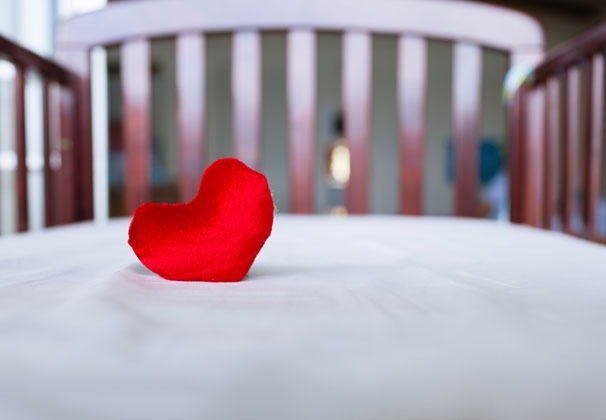尽你所能预防婴儿猝死综合症。
SIDS是指1岁以下婴儿突然不明原因死亡。没有任何单一的风险因素可能导致小岛屿发展中国家的死亡。相反,若干综合风险因素可能导致小岛屿发展中国家的死亡。
Most SIDS-related deaths occur between 2 to 4 months of age, with the incidence increasing during cold weather. SIDS is more likely to occur in boys than girls and in African-American and Native American infants.
Most SIDS deaths are associated with sleep (cot death/crib death). Nearly 3,500 U.S. infants die suddenly and unexpectedly each year. SIDS incidences have been reduced with implementation of practices advocated by the American Academy of Pediatrics (AAP).
Among the risk factors are: smoking, drinking or drug abuse during pregnancy; poor prenatal care during pregnancy; premature birth or low birth weight; mothers younger than 20; secondhand tobacco smoke exposure; previous episodes of apparent life-threatening events; and apnea.
But you can help reduce some risks. Your baby should sleep on a firm, flat surface, cuddled up only in his or her pajamas. That’s all your baby needs. Let’s learn what you can do to keep baby safe.
Clear the clutter
清理宝宝的睡眠区域的毯子,枕头,毛绒玩具或保险杠垫。
The risk:Soft and decorative items in a baby’s sleep area increase the risk for suffocation or sudden infant death syndrome (SIDS). Your baby isn’t strong or coordinated enough to remove soft items from his or her face.
Not too warm
Use a sleep sack, not a blanket, to keep your baby warm if you are worried about the cold. Dressing baby in one less layer than you have on should keep baby comfortable and not overheated.
The risk:研究表明,过热的婴儿会进入深度睡眠,而他或她很难醒来。过多的衣服或毯子以及房间里较高的温度会增加婴儿的风险。
Breastfeed as long as you can
The risk:Breastfed babies have a lower risk of SIDS.
Back to sleep
在宝宝1岁之前,应该让宝宝仰卧,而不是侧卧或俯卧。每一个小憩,每一个夜晚,每一次。
Firm, flat surface
A crib, bassinet or pack ‘n’ play is safe. If your baby falls asleep in a car seat, stroller, swing or infant carrier, move her to a firm sleep surface. Never let your baby sleep on a couch or chair.
The risk:Infant equipment that is not made for sleeping can put your baby in dangerous positions that restrict airflow.
Share your room, not your bed
Room sharing is recommended, ideally for a year but especially the first six months. Place your baby’s crib, bassinet or pack ‘n’ play close to your bed.
The risk:The American Academy of Pediatrics recommends room sharing because it can decrease the risk of SIDS by as much as 50%, and it is much safer than bed sharing.
Get that air moving
A well-ventilated sleeping area is safer for a baby.
The risk: According to one study, sleeping with a fan lowers the risk of SIDS by 70%.
More prevention tips
- Receive early and regular prenatal care.
- 确保你的宝宝接受所有推荐的免疫接种。研究表明,接种过疫苗的婴儿成为SIDS受害者的可能性降低了50%。
- Make sure your baby has regular well-baby checkups.
- If your baby has gastroesophageal reflux disease (GERD), follow your doctor’s guidelines on feeding and sleep positions.
- Never sleep with your baby or allow other children to sleep with baby.
- Give your baby plenty of interactive tummy playtime.
- 当你带宝宝旅行时,一定要为他/她准备一个安全的地方睡觉。
- Contact hotels regarding the availability of a safe crib for a short overnight trip.
- If you take your baby to day care or leave him with a baby sitter, provide a copy of this list to them. Make sure they follow all these recommendations.
These simple changes can dramatically lower your baby’s risk for SIDS. Communicate these to any caregivers of your child as well. For more information, see theSAFE to SLEEP educational website.
Read more
- New baby checklist: Everything from cribs to clothing
- Childhood exercise: How much do they need each day?
- Whooping cough: You may need booster as vaccine fades
FAQs: Understanding SIDS safety
为婴儿选择一个安全的空间睡觉有助于降低婴儿猝死综合症(SIDS)的风险。虽然小岛屿发展中国家的原因尚不完全清楚,但减少环境因素有助于减少风险。如果可能的话,让宝宝睡在婴儿床的平面上。如果宝宝在秋千或汽车座椅上睡着了,一定要把孩子转移到婴儿床上。
婴儿安全睡觉的最好地方是婴儿床或平坦的床上。婴儿床应该是光秃秃的——没有毯子、保险杠或填充动物玩具。床应该是牢固的,应该只有一个合适的床单在上面。如果父母担心宝宝会觉得太冷,那就用睡袋代替毯子。
应该让婴儿平躺着睡觉。让他们平躺着睡觉,即使他们已经能移动并能自己翻身了。
…
Posted InChildren's,Health Information,Parenting,Pregnancy,Sleep Medicine,Specialty Care
